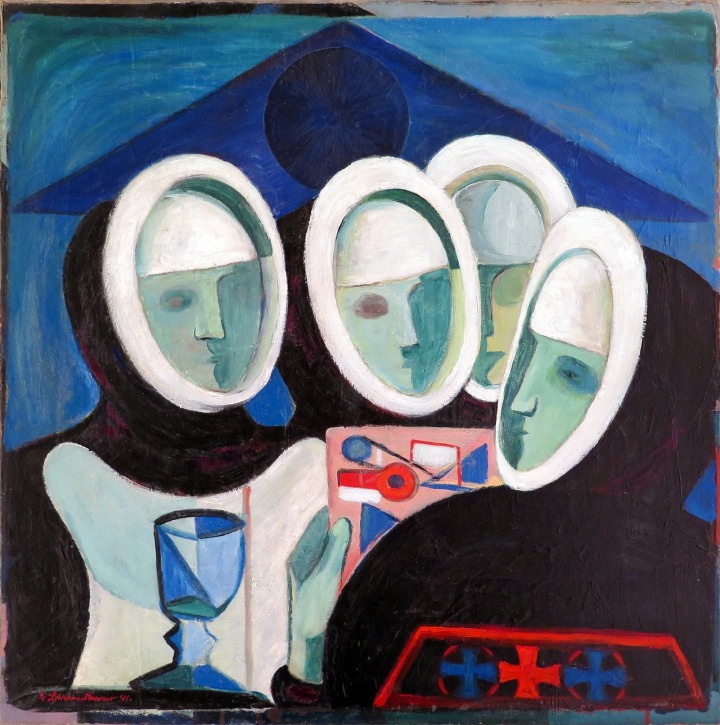Fritz Brandtner’s "The Four Nuns" (1941) and Social Realism
Believing that art offered a path to regaining emotional and physical health, in 1936 Fritz Brandtner and Dr. Norman Bethune founded a program to teach art to sick children at Montreal's Memorial Hospital and Hôpital du Sacré-Coeur (Sacred Heart) [1]. Medical subject matter is featured occasionally in Brandtner's figurative work.
The 1936 pen and ink drawing Dr. Norman Bethune Hospital du Sacré-Coeur, Cartierville [Fig. 2] features a group of nuns watching as the prominent physician treats a patient at Sacred Heart, which was one of the hospitals offering medical treatment to the poor. (It was not until 1957 that a limited version of public health care was introduced Canada-wide. In 1967, this was expanded in favour of universal health care). The pen and ink drawing was developed by the artist into a painting [Fig. 3], which is illustrated in Healing the World's Children: Interdisciplinary Perspectives on Child Health in the Twentieth Century, but its details and whereabouts are unknown [2].
The arrangement and stylization of the figures in The Four Nuns [Fig. 1], 1941 is remarkably similar to the 1936 drawing and even more so to the lower right quadrant of the mystery painting. Instead of observing Bethune treating a patient, however, the nurses in The Four Nuns appear to be examining an abstract image. Using these images, we can infer that the subject in The Four Nuns is nurses at Sacré-Coeur hospital. The addition of abstract forms to the object they are holding leads us to speculate that they may be examining a work of art painted by one of the hospital's young patients under Brandtner's tutelage.
Brandtner had arrived in Canada in 1928, settling in Winnipeg. In addition to exhibiting as a creative artist, he found work as a commercial artist, muralist and set designer. During this time, he became acquainted with the impressive roster of artists also residing in Winnipeg, including Bertram Brooker, Lionel Lemoine Fitzgerald, Caven Atkins and Philip Surrey.
In 1934, having been placed in contact with the art critic Robert Ayre, Brandtner was encouraged to move to Montreal where he met artists Louis Muhlstock, André Biéler, John Lyman, and Anne Savage. There, he first got a job at Eaton's, working in the Display Department and earning $20 a week [3].
Dr. Norman Bethune had also been among Brandtner's first contacts in Montreal. Bethune was a renowned physician and an amateur artist. He was also a prominent communist during the depression era, whose causes included advocating for public healthcare. Brandtner and Bethune shared an interest in social issues and in 1936 they, along with Marian Scott, founded the Children's Art Centre.
At the turn of the century, modern artists including Picasso looked to children's art among other influences to find 'unspoiled' sources of inspiration to break from the academic tradition. In 1936, artist John Lyman echoed this sentiment in a review of an exhibition of children's art curated by Brandtner [4]. Could Brandtner have been paying homage to the roots of modernism broadly and maybe even furthering his own exploration of modern art? We would need confirmation from him.
In 1936, when Bethune left for Spain, he rented his Beaver Hall Square apartment to Brandtner [5]. An uncited photo of the flat-turned studio appears in The Brave New World of Fritz Brandtner and The Four Nuns, 1941 can be seen hanging on the wall [Fig. 4]. On the back of the original frame, which is still on the painting, we find Brandtner's Beaver Hall Square studio stamp.
Brandtner selected The Four Nuns to represent him in the 1942 Canadian Group of Painters Exhibition [6]. It encapsulates the artist's interest in social issues and the greater power of art.
Nadine Di Monte and Anna Orton-Hatzis contributed excellent research to this appreciation.
ENDNOTES
1. Charles C. Hill, Canadian Painting in the Thirties, (Ottawa: National Gallery of Canada, 1975), p. 129.
2. Cynthia Comacchio, Janet Lynne Golden, George Weisz, eds., Healing the World's Children: Interdisciplinary Perspectives on Child Health in the Twentieth Century, (Montreal: McGill-Queen's Press, 2008), p. 262
3. Helen Duffy & Frances K. Smith, The Brave New World of Fritz Brandtner, (Kingston, ON: Agnes Etherington Art Centre, Queen's University, 1982), p. 31
4. Suzanne Lemerise and Leah Sherman, "Modern Art and Child Art in Quebec: The Symbiotic Relationship between Art Field and Child Art," in Harold Pearse, From Drawing to Visual Culture: A History of Art Education in Canada, (Montreal: McGill-Queen's University Press, 2006), chapter 6.
Note: Lyman wrote in his exhibition review, "The vivid spontaneity and naive directness with which the children pro- duced their imaginative experience took all the starch out of the perfunctory academics [...]"
5. Duffy & Frances K. Smith, The Brave New World of Fritz Brandtner, p. 34
6. Art Gallery of Toronto, Canadian Group of Painters, February 1942, cat. No. 86, as "The Four Nuns, $200.00"
EXTERNAL IMAGES CITED
Fig. 2. Fritz Brandtner, Dr. Norman Bethune Hospital du Sacré-Coeur, Cartierville, 1936, ink drawing, 7 ¼ x 6 ¼ in., Private Collection, illustrated in 100 years of Fritz Brandtner, exh. cat., (Westmount, Québec: Kastel Gallery, 1996), repro- duced, p. 22
Fig. 3. Painting of Dr. Norman Bethune’s first operation at Sacré Coeur Hospital, Cartierville, Quebec, [in] 1933, by Montreal painter Fritz Brandtner, Photograph of the painting from The National Film Board of Canada. Photothèque / Library and Archives Canada / PA-114792, illustrated in Cynthia Comacchio, Janet Lynne Golden, George Weisz, eds., Healing the World’s Children: Interdisciplinary Perspectives on Child Health in the Twentieth Century, (Montreal: Mc- Gill-Queen’s Press, 2008), p. 262
Fig. 4. Interior of Brandtner’s studio at 1154 Beaver Hall square with The Four Nuns hung on the wall at right, from Helen Duffy and Frances K. Smith, The Brave New World of Fritz Brandtner, (Kingston, ON: Agnes Etherington Art Centre, Queen’s University, 1982), fig. 7, p. 34













